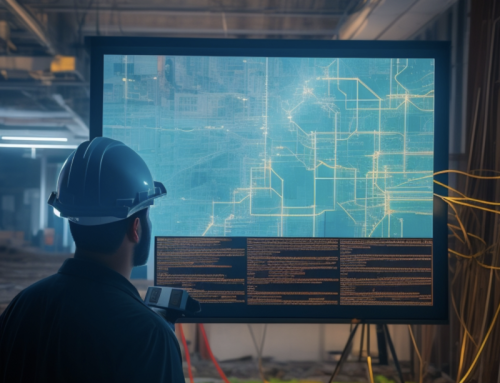The New Approach to Safety Management Systems that Achieves Next-Level Results
April 8, 2019/by Barry Nelson
Tricia Kagerer is an award-winning risk management executive with the American Contractors Insurance Group (ACIG), where she has kept a watchful eye on the dramatic shifts in workplace safety over the years.
By working closely with general contractors and construction companies across the United States, she has helped manage their safety, implement best practices, prevent losses, and mitigate accidents and injuries. Tricia has seen firsthand the ways safety practices have advanced, as well as the unfortunate ways they have stagnated.
“New ways to think about safety and technology are coming fast, and it’s time to embrace them in the construction industry.”
We had an opportunity to speak with Tricia for her insights on the evolving field of safety, and where today’s companies can focus their safety initiatives to achieve the best results.
Root of Today’s Issues: Safety needs Stronger ways to Engage the People Closest to the Work each Morning
On the topic of what problems that current approaches to safety fail to address effectively, Tricia zeroed in on how job hazard analysis processes have been focused in the wrong direction.
Tricia: Safety has evolved so much over the years. It has taken off as being its own entity, its own profession. But unfortunately, safety is also still something that’s separated from operations and field performance.
In the last 20 years, safety professionals have been trying to figure out on their own what special safety process, or procedure, or checklist will change things in the field and prevent accidents. There’s so much focus on compliance and signatures, all looking at documenting how someone was told to do something a certain way.
But due to our love of documentation, we’ve lost how to effectively communicate with and engage those closest to the work—which is really, really, dangerous.
This means craft workers often aren’t “switched on”, or don’t have the information they need to avoid hazards, resulting in far too many avoidable accidents or injuries
“Checklist tools and form filling aren’t going to give you employee engagement.”
Unless those closest to the work are ENGAGED, no form-filling exercise is going to be sufficient in getting folks home safely.
Tricia: The reality is the workforce is diluted, and there’s more work that needs doing than ever before.
The old masters of construction have retired, or left the industry, but there’s still an expectation that people somehow know how to do their work from a quality and safety perspective. That’s a false perception.
Responding to the Problem: A Connected Safety Network
With countless safety issues being traced back to low engagement and poor communication, Tricia recognizes the need for technology providers to transition their focus.
To keep people safe in modern work environments, it’s become necessary to evolve from just measuring if something was said, to measuring the quality of how information was exchanged, and embraced, during JHA or PreTask Planning conversations.
“There are a lot of platforms out there in the compliance checklist software market, but what SmartTagIt is doing is completely different.”
Tricia turned to the SmartTagIt software developed by FactorLab—who is taking a fresh approach to Safety Management Systems.
SmartTagIt combines data gathering applications and business analytics tools, along with video and image capture, to empower a safety network that keeps those closest to the work connected, informed, and engaged.
Tricia: We’ve lost the human element of communication and connection in safety.
But what Factorlab and SmartTagIt are doing is providing a means to get away from the checklist, and get people engage with their foreman, and superintendent, and leadership.
This actually improves communication and makes connections with people in the field to ensure they can do their job safely, rather than just taking the time regurgitating a checklist.
When asked why she believes companies should implement this sort of technology-fueled approach to safety management, Tricia emphasized how the mindsets of the people entering the safety field are changing, and to successfully appeal to them, safety must adapt.
Tricia: It’s the new generation. Auditing is only going to get you so far. Having someone come out with a checklist to document what’s happening in the field, to see if someone did a job right after the fact, isn’t enough.
Checklist tools and form filling aren’t going to give you employee engagement. We’ve lost that. What people are expecting now that they’ve been raised by social media is a human connection, which is what SmartTagIt is provides.
Any industry that requires job hazard analysis, or compliance forms, would be well served by SmartTagIt. Or really, any work where you have people in the field with limited supervision and an expectation that workers should know what they’re supposed to be doing.
There are a lot of platforms out there in the compliance checklist software market, but what SmartTagIt is doing is completely different. It’s an opportunity for management that’s stretched really thin to interact and engage with those most exposed to danger and death, which is important.
It provides a more hands on way to communicate with workers, and the data analytics are second to none. They gather and analyze data in a way that actually points safety professionals in directions they were never able to see before, because the technology simply wasn’t there. It’s guiding people to improve safety in new ways.
Conclusion: Mark Zuckerberg figured out how to get people engaged. Now Safety Professionals can do the same.
On a final note, Tricia commented on how she feels that many safety initiatives tend to be rooted in old routines, especially when it comes to construction.
Tricia: Twitter, Instagram and Facebook have shown us there are new ways to get people engaged, and it’s time to embrace it in the construction industry.
This is one of the industries that has been slowest to change, but here’s an opportunity to move quickly and actually make a difference.
As new effective solutions present themselves for keeping people safer and productivity higher, companies can’t afford to ignore those innovations.
After all, it’s a fact that modern tech is providing safety with exciting new capabilities to grow. But for it to actually do so, we must refocus our efforts on what matters most—using technology to get those closest to the work engaged, each and every day.






